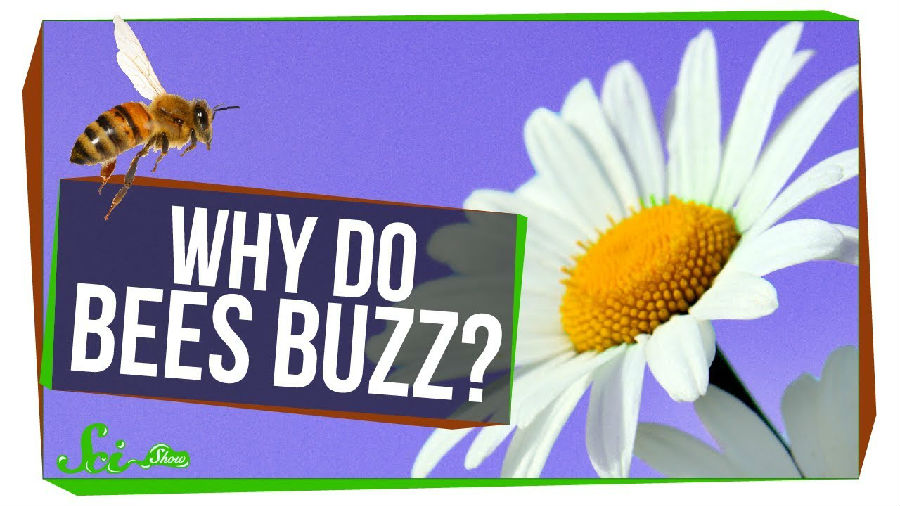Plenty of insects buzz when they fly around, like beetles and that little eeeeeeeee of a mosquitoes. I hate that noise so much!
很多昆虫在飞来飞去的时候都会发出嗡嗡声,比如甲壳虫和蚊子。我非常讨厌这种声音!
But bees are kind of special. There are more than 20,000 species of bees, all of which buzz when they fly, and many of which also do it to communicate.
但是蜜蜂有些特别。世上有两万多种蜜蜂,它们在飞行的时候都会发出翁嗡声,其中一些也是为了交流。
But some bees buzz for a completely different reason that has nothing to do with communication or with flight
但是一些蜜蜂发出翁嗡声完全是出于不同的原因,和交流或是飞行完全无关
They're trying to get pollen out of flowers, in what's known as buzz pollination.
它们是想要从花朵中获取花粉,这被称为蜂鸣授粉。
The kind of buzzing we hear when bees fly comes from their wings, which they can flap at up to 230 beats per second.
我们所听到的那种蜜蜂起飞时的翁嗡声来自于它们的翅膀,它们每秒钟可拍打230次。
Their quick wing movements cause air vibrations, which your ear translates to sound.
它们翅膀的迅速动作会导致空气振动,也就是你所听到的声音。
The faster the wings beat, the higher the pitch.
翅膀拍打的越快,音调就越高。
And if you've ever had the unfortunate experience of disturbing a hive, you've probably seen them buzz a little louder in agitation.
如果你有扰乱蜂巢的不幸经历,那么你或许亲眼目睹了它们急躁地发出更吵闹的嗡嗡声。
But in buzz pollination, they generate sound energy by vibrating their bodies, not their wings.
但是在蜂鸣授粉时,它们通过震动自己的身体而非翅膀来制造音能。
They use the same muscles they'd normally use to move their wings,
它们使用的是拍动翅膀的同一块肌肉,
but kind of separate their wings from those muscles so their bodies vibrate instead, at about 400 beats per second.
但是会将它们的翅膀和那些肌肉分开,这样就可以震动它们的身体,每秒约400次。
This full-body vibration causes the distinct buzzing sound you hear when bees are on a flower,
当蜜蜂在花上采蜜时,这种全身的震动可以制造出一种独特的声音,
which is a bit louder and higher pitched than regular flying buzzing. It's actually in the tone of middle C.
相比正常的飞行嗡嗡声,这种声音更大、音调更高。其实这是中央C音。
That exact middle C buzzing is like a secret passcode that unlocks pollen trapped inside flowers.
这种中央C音像是一个密码,可以解锁被困在花朵中的花粉。
But bees don't need to do it for every kind of flower.
但不是每种花都需要蜜蜂这么做。
Most flowers are like a buffet: their pollen is on the outside of the anther
大部分花朵都像是自助餐一样:它们的花粉就在花粉囊的外边
–the male part of the flower – and just about anyone can come take it.
—花朵中的雄性部分—并且任何人都可随意采取。
But there are some flowers, like the ones on tomato and blueberry plants, that have poricidal anthers.
但有一些花是孔裂花粉囊,比如西红柿和蓝莓的花。

These anthers lock the pollen inside them, with just a small pore for an opening.
这些花粉囊将花粉锁在了里边,只留有一个小气孔。
To get the pollen out, the bees wrap their legs around the flower, bite down on the anther for grip, and buzz.
为了取得花粉,蜜蜂需要将腿包裹着花朵,咬住花粉囊稳住自己,并发出嗡嗡声。
When they vibrate at that super high speed, the pollen bounces up and down in the tube,
当它们以超高速震动时,花粉会在管子里上蹿下跳,
and when it gains enough momentum, a bunch of it explodes out and lands on the bee.
当积攒了足够的势头后,一堆花粉就会蹦出来落在蜜蜂身上。
Only some bees can do this, like bumblebees and a few kinds of solitary bees.
仅有一些蜜蜂可以做到,比如大黄蜂以及几种独居蜜蜂。
Honeybees can't. But, for the record, you don't really need a bee if you want to get the pollen out.
蜜蜂不幸。但郑重声明,如果你想取出花粉,并不需要一只蜜蜂。
A tuning fork will do, or if you want to get more hi-tech you can get tools to vibrate the plant at the right frequency.
用一支音叉就可以了或者如果你想更高科技一些,你可以拿着工具以正确频率震动植物。
Which yes, do exist, and people actually use them to pollinate their plants — although they're not as efficient as the natural method.
这种工具确实存在,但其实人们用它们来给植物授粉—虽然不如自然授粉那么高效。
Because when it comes to getting up close and personal with a flower, bees are definitely the experts.
因为说起与花朵亲近,蜜蜂才是行家。
If you're interested in more of the weirdest bee facts out there, you should definitely check out the bee-themed episode of SciShow Tangents,
如果你对蜜蜂秘事感兴趣,你绝对应该去看看SciShow Tangents的蜜蜂主题专辑,
our weekly podcast produced in collaboration with WNYC studios.
Tangents是我们和WNYC合作出品的播客节目。
I was on that episode, I'm on all of the episodes, and I was just shocked by how many fascinating things about bees there are!
我也主持了该专辑,哪哪都有我,有那么多关于蜜蜂的有趣事情,我也是吓了一跳!
There are four of us on the podcast and every week, we share the most awesome facts we can find about a topic.
播客中有我们的四名主持人,我们每周都会讲述一个主题。
There are different segments, like one where we answer viewer questions,
节目中会有不同环节,比如我们会回答观众的问题
and another where someone presents one true fact and two fake ones and the rest of us have to try and figure out which is true.
比如,从一个事实和两个谎言中找到真相的环节。
It's harder than you'd think, especially when Ceri is doing it … there's a lot of science out there that's so weird it sounds made up!
比你想的要难,尤其是Ceri出的题...节目中有很多关于科学的知识。
Oh, and we try to end every episode with a fact about butts. And now, I know a lot of butt facts.
我们试着以一个关于屁屁的事实来结束每期节目。目前我已经知道很多关于屁屁的真相。
You can too! Along the way, we go on a number of tangents, which is where the name comes from.
你也可以!一期节目下来,我们经常跑题,这个节目的名字由此而来。
You can check it out wherever you get your podcasts!
欢迎前往播客收看!


